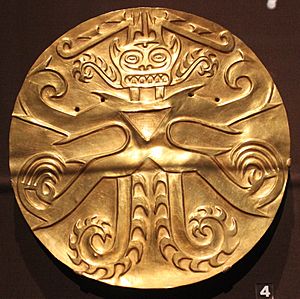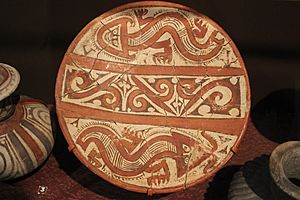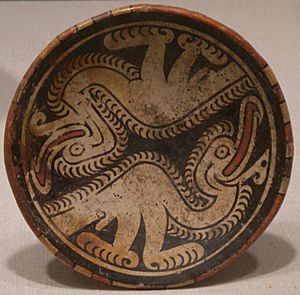Sitio Conte facts for kids
Sitio Conte is an ancient burial ground in the Coclé province of Panama. It's located near Parita Bay. This site is a great example of a "chiefdom" society, which means it was led by powerful chiefs. People used Sitio Conte from about 450 AD to 900 AD. Even though no one has dug there since 1940, the graves are very important. They help archaeologists understand how people lived in this region between 500 AD and 1500 AD.
Contents
Where is Sitio Conte Located?
The site sits on the eastern bank of the Rio Grande de Coclé river. It spreads out east, north, and south along the river. Around the site, you can see grasslands and small hills. To the north are the Tabasará Mountains, and to the south is Parita Bay.
The most important parts of the site are the graves themselves. There aren't many buildings or structures. However, there are two rows of large, rough standing stones, about 2 meters (6.5 feet) tall. These stones were found with smaller, flat-topped stones that archaeologists called "altars." There were also two flat floors and a large pile of rough stones.
A Quick Look at Sitio Conte's Past
We don't know a lot about the people buried at Sitio Conte. Experts have different ideas about what the site was for. Some think it was a "summer home," while others believe it was a shared burial ground. The people buried there might have been "chiefly families" or "chiefs and warriors" who died in a battle.
Archaeologists know when the site was used by looking at the gold and pottery found in the graves. These artifacts show that the site was active from about 450 AD to 900 AD. Around 900 AD, people stopped using the cemetery. However, it seems that some people continued to live in the area, based on old household trash found there.
Digging Up History at Sitio Conte
In the late 1800s, the Rio Grande de Coclé river changed its path. It started to cut through the western edge of Sitio Conte. This washed many ancient objects downstream. People collected and sold these items. Some were even shown by the Panamanian government in 1915 when the Panama Canal opened. In 1927, the river changed course again, sending more objects downriver.
In 1928, the Conte family, who owned the land, dug a pit. They found some of the large stone columns that archaeologists later wrote about. Some of these objects went to the Peabody Museum at Harvard University. This made the museum's curator, Alfred M. Tozzer, very interested. Tozzer and Earnest A. Hooten visited the site that same year. They made plans for the Peabody Museum to start digging.
In 1930, archaeologist Henry Roberts began the first scientific dig in Panama at Sitio Conte. Roberts also led the excavations the next year. In 1933, the Peabody Museum returned under Samuel K. Lothrop. All three years of digging by the Peabody Museum were very successful. They found 59 graves and 38 "caches" (hidden groups of objects). They also uncovered many gold items and colorful pottery.
In the late 1930s, the Conte family asked the Peabody Museum to come back for more digs. The museum's director said no. Instead, he suggested that J. Alden Mason from the University Museum of Archaeology and Anthropology (the Penn Museum) in Philadelphia continue the work. In 1940, Mason and his team had another successful excavation. They found 41 graves with many valuable items. This was the last time professional archaeologists dug at the site.
Some experts have criticized how these early excavations were done. They felt that the archaeologists didn't always record information carefully enough. For example, Olga Linares thought that good ways to study the layers of soil were skipped to save time. Others said that the notes about the artifacts were not clear.
Archaeologists at Sitio Conte found 228 dogs buried there. They also found many dog teeth used as decorations. For example, some were made into beads on an apron found with an important woman. Katherine B. Moore, from the University of Pennsylvania, studied these dog teeth. She found they came from one type of dog. This suggests how dogs came to South America and were tamed.
Important Graves Found at Sitio Conte
Grave 1: The Chief's Burial
Grave 1 was one of the most important graves found by the Peabody Museum. It dates back to 400-500 AD. Experts believe it held a "chief and three of his helpers." The main person, skeleton 1, was buried sitting up. They were covered in amazing grave goods. These included eight special pots shaped like figures and 112 plates or bowls. All these items were placed around the edge of the grave.
Other treasures included gold or tumbaga (a gold and copper mix) beads, pendants, leg coverings, and chisels. There was also an apron made of dog teeth, mirror backs, whale teeth, and carved manatee ribs with gold on them. Seventeen hundred serpentine beads and bundles of stingray spines were also found. The other skeletons in the grave had similar items, but fewer of them.
Grave 5: Many Burials Together
Grave 5 dates to around 700-900 AD. It held fifteen skeletons and many grave goods. The main skeleton (15) was buried sitting up. It was originally inside a small, temporary hut that had since fallen apart. This person's grave goods included a carved whale tooth pendant, stone mirror backs, and gold or tumbaga leg coverings, cuffs, plaques, and a helmet. On the floor of the grave were stone slabs, tortoise shells, and various pottery pieces.
Eight of the other fourteen skeletons were along the south and west sides of the grave. The other six were on the northern edge. Archaeologist Lothrop thought the northern group might have been from an earlier burial. Some of their grave goods included pendants made of bone, gold, and stone.
Grave 26: A Rich Discovery
Grave 26 was one of the richest graves found by the Peabody Museum. It contained 22 skeletons and is from the same time as Grave 5. The main person, skeleton 12, was buried sitting up. They were once inside a makeshift hut. The floor of the grave was made of many pottery pieces, a stone slab, and the rest of the people buried there.
Some of the items found with the main burial included gold or tumbaga plaques, cuffs, leg coverings, beads, carved whale teeth, manatee ribs, stingray spines, and an emerald. Out of 126 pottery pieces in Grave 26, most lined the walls of the grave. These included 36 pots shaped like figures and 90 colorful plates. The other people in the grave had a few items, like gold ear rods found with Skeleton 8.
Grave 74: Layers of Treasure
Grave 74 was dug up in 1940 by J. Alden Mason's team. It dates to 700-900 AD and is one of the richest graves at Sitio Conte. The main people, skeletons 15 and 16, were found lying on top of each other in the middle layer. This grave held over 7,500 burial items and 23 skeletons placed on three different levels.
Upper Level Finds
As Mason's team dug, they found eight skeletons lying face down and side-by-side. Six were older men, and two couldn't be identified by gender. Their grave goods included pottery, stone arrowheads, stone tools (celts), and a special winged stone pendant. Skeleton 4 had a pile of stone points at its feet. It also had a pile of gold beads and five gold plaques lying on top of it. Whole pots and broken pottery pieces lined the north and south ends of the burial, continuing down to the second level.
Middle Level Discoveries
Digging deeper, the team found a second level of burials. This level had twelve skeletons with thousands of grave goods. The main people of the grave, skeletons 15 and 16, were in the center of this level. Five skeletons were on their east side, three on the west, and single skeletons on the north and south ends.
Many items were found with the central individuals. These included many gold plaques (some plain, some with designs), ear rods, bells, leg coverings, and beads. There were also many stone arrowheads and celts. The most famous item found with these people is a gold animal pendant with an emerald in its back. It was found upside down on top of the gold plaques covering the two central individuals.
Many items were placed with the other people in this grave. These included gold triangles, a pair of whale teeth, a carved figure covered with gold, dog teeth, several green arrowheads, and a stone celt.
It was on this level that the "ceramic wall" (a thick layer of pottery) was at its thickest, about 30 centimeters (12 inches). The excavators became overwhelmed by the huge amount of pottery. They removed many pots without writing down all the details. Mason noted that the team got "gold fever." They were eager to remove the pots to get to the gold objects underneath.
Lower Level Treasures
After clearing the second level, the team reached the lowest part of the grave. They removed a layer of broken pottery and dirt. They found three skeletons. The person in the center, skeleton 21, lay on its side. The other two lay face down. Two of the skeletons, 21 and 22, had a few items with them. These included a gold bat pendant, ear rods, some stone celts, and a large gold plaque with a raised design.
The Art of Sitio Conte
The gold and pottery pieces from Sitio Conte show very skilled artwork. Some figures are abstract animals. Others look like a mix of human and animal forms. These figures usually appear in one or two designs. Sometimes, pottery pieces have many different images.
The gold pieces show animals like bats, deer, sharks, crocodiles, and lizard-like creatures. They also show human and part-human figures. Many of these same animals appear on the colorful Coclé-style pottery found in the graves. These include snakes, birds, turtles, crabs, insects, frogs, stingrays, armadillos, and monkeys. It's thought that these gold and pottery items showed how important the buried people were.
Sitio Conte Today
No professional archaeologists have dug at Sitio Conte since Mason's excavation in 1940. The land where the site is located belongs to the Conte family in Coclé. Today, it is used as farmland.
See also
 In Spanish: Sitio Conte para niños
In Spanish: Sitio Conte para niños






